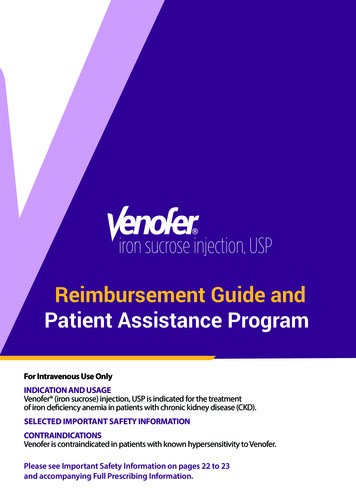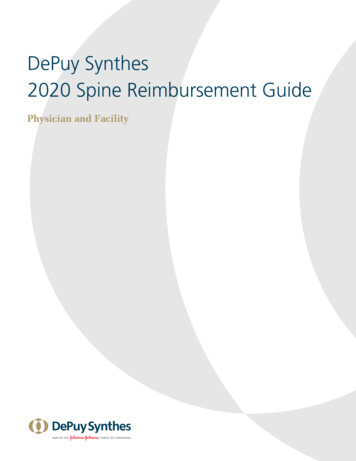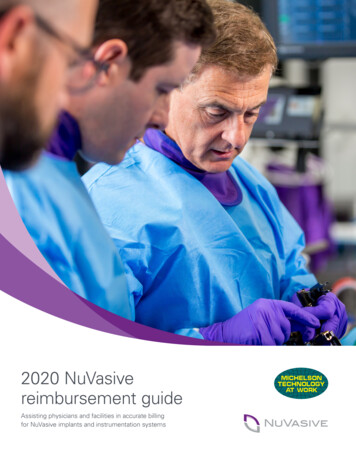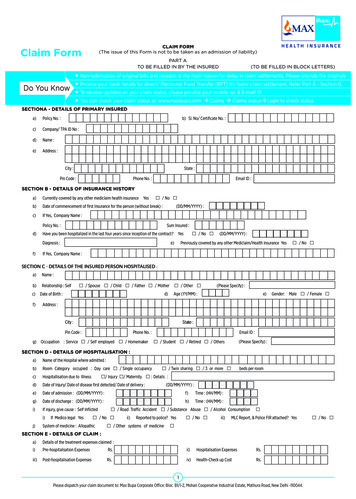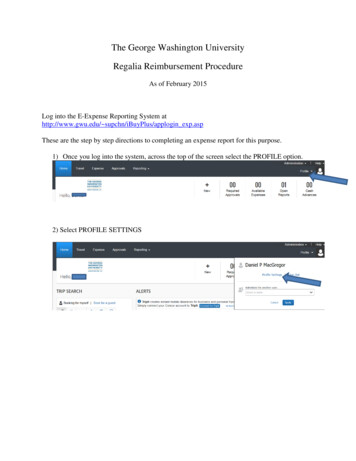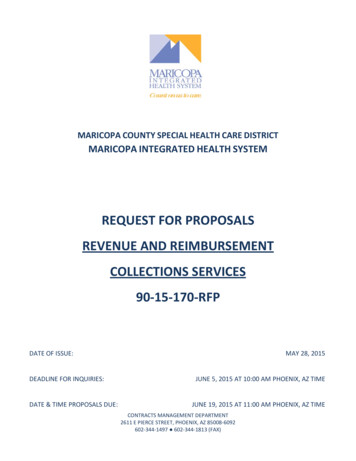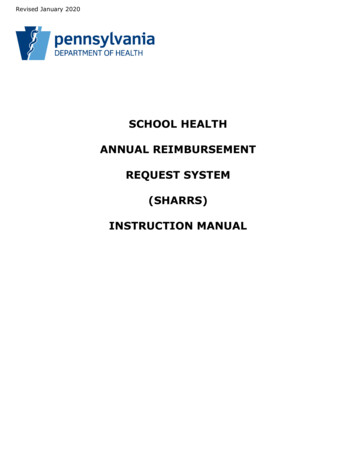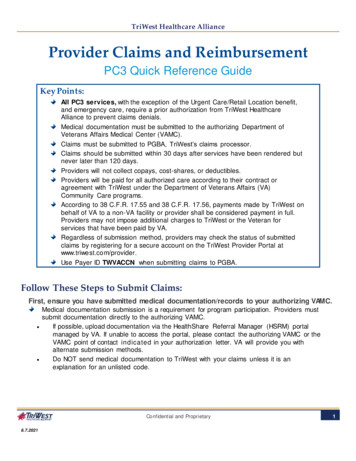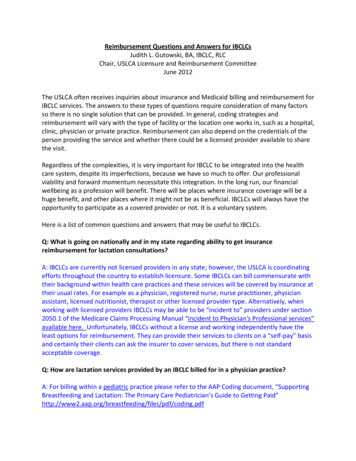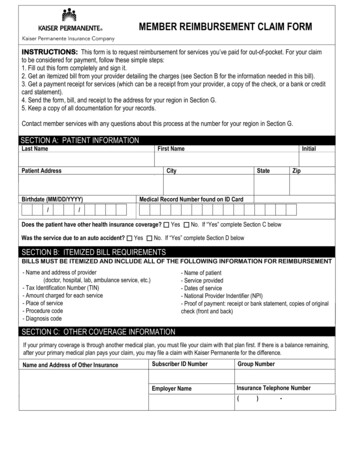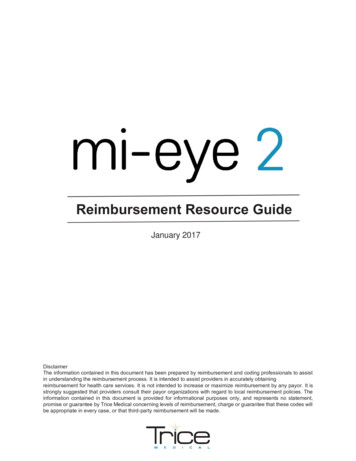
Transcription
Reimbursement Resource GuideJanuary 2017DisclaimerThe information contained in this document has been prepared by reimbursement and coding professionals to assistin understanding the reimbursement process. It is intended to assist providers in accurately obtainingreimbursement for health care services. It is not intended to increase or maximize reimbursement by any payor. It isstrongly suggested that providers consult their payor organizations with regard to local reimbursement policies. Theinformation contained in this document is provided for informational purposes only, and represents no statement,promise or guarantee by Trice Medical concerning levels of reimbursement, charge or guarantee that these codes willbe appropriate in every case, or that third-party reimbursement will be made.
1Technology OverviewThe mi-eye, Camera Enabled Probe is a battery operated, portable, visualization device that uses a probe withintegrated camera and separate LCD monitor attached via cable. The probe includes the camera and the imagecapture features with LED light source. The LCD Monitor displays real-time video from the probe and isattached via cable to provide power to the probe. The probe scope extends from the handle as a rigid shaft withretractable needle and flushing port for cleaning the field of view. The distal tip of the probe contains theillumination and imaging optics.The Trice Camera Enabled Probe is indicated to be used by a trained physician to provide illumination andvisualization of an interior cavity of the body through a natural or surgical opening in diagnostic and operativearthroscopic and endoscopic procedures.The mi-eye technology received FDA 510(k) clearance on July 29th 2014. It is considered to be a Class IIdevice under the trade name of “camera enabled probe” commonly known as an arthroscope.
2Coding BasicsWhenever code assignment is discussed for new or existing procedures or technologies, the different codingand reimbursement pathways and types of code sets used should be reviewed. Distinct code sets are used toreport various aspects of procedures and technologies for reimbursement depending on the entity billing thecase.Reimbursement pathways and appropriate code sets take two directions resulting in two separatereimbursements for a single patient encounter when performed in a facility. Physicians and surgeons report theirwork separately from the facility where the procedure is performed. This in turn creates unique coding pathwaysfor each side of the equation that results in appropriate reimbursement from third party payors (such asMedicare or private payors).Surgical CaseSurgeon Reimbursement CodesFacility Reimbursement CodesInpatient CodesOutpatient CodesWhen procedures indicated for the use of the mi-eye technology are performed within the physician officesetting of care the physician may be reimbursed not only for the work performed during the procedure but alsofor the office expenses included in the procedure. The extent of available reimbursement for an in-officeprocedure is dependent on specific payor guidelines and should be reviewed for each case through a preauthorization or benefits verification.Surgeon Codes – Physician services and surgical procedures are reported using Common ProceduralTerminology (CPT) codes. These codes are created by the American Medical Association (AMA). These codesare reported across all settings of care including the physician office, outpatient and inpatient facility. Medicareand many private health plans rely primarily on Current Procedural Terminology (CPT ) codes to describeprocedures performed in the physician office, ambulatory surgery center, and hospital outpatient department.CPT codes are developed, maintained, and annually updated by the American Medical Association (AMA).Please note that the assignment of a CPT code to a procedure does not guarantee coverage or payment by ahealth plan in all cases.Under Medicare’s Resource-Based Relative Value Scale (RBRVS) methodology each CPT code is assigned avalue, the relative value unit (RVU), which is then converted to a payment amount.American Medical Association. CPT codes and descriptions are copyright by the American Medical Association. All rights reserved.
“Unlisted” CPT Codes “Unlisted” permanent CPT codes are used to report procedures that do not preciselyfall into the description of a current CPT code per CPT/AMA guidelines. CPT coding guidelines require thatCPT codes be assigned to procedures that exactly match the current use and description of a published code.Unlisted codes are often used for new technologies as they come to market and require that surgeonsreporting these codes provide the payor with an explanation of the procedure as performed and a request forreimbursement based on the detail and medical necessity of the case.Facility Codes – Surgical procedures are performed in either the office, outpatient or inpatient setting of care,as determined by the physician. Each setting utilizes a different code set to report their services to the payorfor reimbursement. This is in addition to the surgeon, who reports his services separately with CPT codes.Outpatient APC Codes, are based on the same CPT codes reported by physicians but these are typicallymapped to or placed into a second code set called Ambulatory Payment Classification (APC) Codes. APCcodes combine CPT procedure services into like groupings that utilize similar resources in the outpatientsetting and are paid an established rate for the particular APC. These APC code sets can be reported andreimbursed singularly or in inclusive groupings, as determined by payor guidelines. Government payors andsome private payors use this system but reimbursement guidelines can differ considerably depending on thepayor and contracted agreements. Medicare reimbursement rates are determined by the OutpatientProspective Payment System (OPPS) and are published semi-annually.The coding pathways provided within this document address different anatomies where the mi-eye technologyis indicated for use and the available coding pathways for the diagnostic procedure. Medicare place of serviceguidelines and reimbursement values are provided as a benchmark for the applicable procedures. Privatepayor reimbursement values, rates and guidelines are carrier and plan specific and may differ significantly.Anecdotally, private payor rates are sometimes based on Medicare RVUs and may be calculated on a factor of120-150% of the benchmarked Medicare rates for estimating reimbursements. Actual reimbursement values,guidelines and rates are contracted agreements and applicable fee schedules/negotiated rates should bereviewed.Centers for Medicare & Medicaid Services Medicare Learning Network. Hospital Outpatient Prospective Payment System. Available spitalOutpaysysfctsht.pdf. (Accessed 12/28/16)
3Coding PathwaysThe following information is intended for provider guidance and allows the surgeon to consider his or herreporting pathways on a case by case basis. Final decision-making regarding coding guidelines for specific thirdparty payors remains in the hands of the provider. Ultimately, the provider has a better understanding of thecoding pathways available and how to use them appropriately in the office setting of care.The coding pathways applicable to the mi-eye technology and associated diagnostic procedures are provided forthe following anatomies; KneeShoulderElbowWristHipAnklePlease note that while there are specific non-facility (office based procedure) Medicare reimbursement values providedfor the knee, other anatomies indicated for utilizing the mi-eye technologies do not provide the non-facility Medicare siteof-service differential. The ability to provide the mi-eye procedure in the office setting of care will be dependent on payorspecific guidelines and policies. A review of applicable values/fee schedules for private payor agreements is suggested.Coding Sheets with facility coding pathways and Medicare reimbursement values are available for relateddiagnostic arthroscopy procedures in a separate document.DisclaimerThis information is for educational/informational purposes only and should not be construed as authoritative. The information presentedhere is current as of January 2017, and is based upon publicly available source information. Codes and values are subject to frequentchange without notice. The entity billing Medicare and/or third party payors is solely responsible for the accuracy of the codes assigned tothe services or items in the medical record. Therefore, health care providers must use great care and validate coding requirements ascribedby payors with whom they work. Trice Medical assumes no responsibility for coding and cannot recommend codes for specific cases. Whenmaking coding decisions, we encourage providers to seek input from the AMA, relevant medical societies, CMS, the local MedicareAdministrative Contractor and other health plans to which claims are submitted. Items and services that are billed to payors must be medicallynecessary and supported by appropriate documentation. Trice Medical does not promote the off-label use of its devices. It is important toremember that while a code may exist describing certain procedures and/or technologies, it does not guarantee payment by payors.
KNEE Diagnostic ArthroscopyTable: Physician Coding PathwaysCPT-4Code1CPT Description29870Arthroscopy, knee, diagnostic, with orwithout synovial biopsy (separate procedure)Medicare RVUs 20172FacilityNon-FacilityWork RVUs 5.19Total RVUs 11.82Work RVUs 5.19Total RVUs 16.67SHOULDER Diagnostic Arthroscopy (Medicare does not provide site-of-service differential)Table: Physician Coding PathwaysCPT-4Code1CPT Description29805Arthroscopy, shoulder, diagnostic, with orwithout synovial biopsy (separate procedure)Medicare RVUs 20172FacilityNon-FacilityWork RVUs 6.03Work RVUs 6.03Total RVUs 13.56Total RVUs 13.56ELBOW Diagnostic Arthroscopy (Medicare does not provide site-of-service differential)Table: Physician Coding PathwaysCPT-4Code1CPT Description29830Arthroscopy, elbow, diagnostic, with orwithout synovial biopsy (separate procedure)Medicare RVUs 20172FacilityNon-FacilityWork RVUs 5.88Total RVUs 13.12Work RVUs 5.88Total RVUs 13.12WRIST Diagnostic Arthroscopy (Medicare does not provide site-of-service differential)Table: Physician Coding PathwaysCPT-4Code1CPT Description29840Arthroscopy, wrist, diagnostic, with orwithout synovial biopsy (separate procedure)Medicare RVUs 20172FacilityNon-FacilityWork RVUs 5.68Total RVUs 12.93Work RVUs 5.68Total RVUs 12.931CPT 2017 Professional Edition, American Medical Association (AMA); CPT is a trademark of the AMA22017 Medicare Physician Fee Schedule, Final Rule RVU File. www.cms.gov
HIP Diagnostic Arthroscopy (Medicare does not provide site-of-service differential)Table: Physician Coding PathwaysCPT-4Code129860CPT DescriptionArthroscopy, hip, diagnostic with or withoutsynovial biopsy (separate procedure)Medicare RVUs 20172FacilityWork RVUs 9.00Total RVUs 18.99Non-FacilityWork RVUs 9.00Total RVUs 18.99ANKLE Diagnostic Arthroscopy (Use of an “unlisted” code required, no ankle diagnosticarthroscopy code is available). The process for using an unlisted code follows.Table: Physician Coding PathwaysCPT-4Code12999912CPT DescriptionUnlisted Procedure, ArthroscopyMedicare RVUs 20172FacilityNon-Facility00CPT 2017 Professional Edition, American Medical Association (AMA); CPT is a trademark of the AMA2017 Medicare Physician Fee Schedule, Final Rule RVU File. www.cms.gov
4Support for Unlisted Coding PathwayWhen a provider determines that no specific CPT code accurately describes a procedure as performed, perCPT coding guidelines, he will report an appropriate unlisted CPT code and provide a special report to thepayor that describes the procedure for coverage and reimbursement consideration. When reporting a mi-eyearthroscopic diagnostic ankle procedure an “unlisted” code is required.An example of the “special report” format follows, including suggested wording for describing the mi-eyearthroscopic technology and positioning of a “crosswalk” code for reimbursement valuation per case specificcontracted payor guidelines. The following sample letter is not intended to be used for direct submission forcase prior authorization, but provides a guide and format found to be useful when obtaining prior authorizationsfor unlisted procedures.Physicians should be mindful of the inappropriate use of template documents in place of case-specific languageand description of actual procedures performed. This letter provides one example of how the submission mightbe formatted to provide a clear and concise explanation of the actual procedure performed and the detailnecessary to depict the technology in regard to the patient-specific medical necessity of the procedure assupported with clinical data and case documentation.
[Site Letterhead][DATE]Health Plan Administrator [HEALTH PLAN NAME] [ADDRESS / PO BOX] [CITY], [STATE] [ZIP CODE]RE: [PATIENT NAME][INSURANCE IDENTIFICATION NUMBER]Special Report for unlisted CPT Code: 29999 (mi-eye Ankle Diagnostic Arthroscopy)On behalf of my patient, [INSERT PATIENT NAME], this letter provides clinical information on this patient’scondition, and a formal explanation of the mi-eye Ankle Diagnostic Arthroscopy Procedure for medically necessaryhealth care services. [INSERT PATIENT NAME] is a [INSERT AGE AND GENDER] who presented to me with[INSERT DIAGNOSIS HERE].Description: Unlisted procedure, arthroscopyReason for use: No permanent CPT code exists to precisely represent the ankle diagnostic arthroscopyprocedure medically necessary for my patient [INSERT PATIENT NAME]. The procedure does not meet thecriteria for a current permanent CPT code. The proposed technique utilizing the mi-eye diagnostic arthroscopyprocedure is described below.Description of Procedure: [SURGEON INSERTS DETAILED PROCEDURE DESCRIPTION INCLUDING THEUSE OF THE mi-eye CAMERA ENABLED PROBE, A BATTERY OPERATED, PORTABLE, ARTHROSCOPICVISUALIZATION DEVICE TECHNOLOGY]Device Description: The mi-eye, Camera Enabled Probe is a battery operated, portable, visualization device thatuses a probe with integrated camera and separate LCD monitor attached via cable. The sterile, single-use probeincludes the camera and image capture features with LED light source. The LCD Monitor displays real- timevideo from the probe and is attached via cable to provide power to the probe. The probe scope extends from thehandle as a rigid shaft with retractable needle and flushing port for cleaning the field of view. The distal tip of theprobe contains the illumination and imaging optics.The Trice Camera Enabled Probe is indicated to be used by a trained physician to provide illumination andvisualization of an interior cavity of the body through a natural or surgical opening in diagnostic and operativearthroscopic and endoscopic procedures.The mi-eye technology received FDA 510(k) clearance on July 29th 2014. It is considered to be a Class II deviceunder the trade name of “camera enabled probe”, commonly known as an arthroscope.Patient’s Clinical Need for the mi-eye Ankle Diagnostic Arthroscopy Procedure: [PATIENT NAME] is a [AGE][GENDER] who presented to me with [DESCRIBE SYMPTOMS WITH SPECIFICITY]. Prior
treatments have included [DESCRIBE CONSERVATIVE CARE, USE OF MEDICATIONS, BRACING ANDAMBULATORY AIDS]. The impact this disability has had on my patient may be described as [DESCRIBEDISABILITY, IMPACT UPON ACTIVITIES OF DAILY LIVING AND WORK].In a discussion with [INSERT MR./MS.] following an exam, a decision was made to move forward withdiagnostic intervention.This letter has provided you with a better depiction of this patient’s clinical history and description of the workinvolved in the mi-eye Ankle Diagnostic Arthroscopy Procedure. It is my sincere hope that this additionalinformation will assist in your valuation of the use of the mi-eye arthroscopic diagnostic procedurerepresented by the unlisted code CPT 29999, and explain the “crosswalk” CPT code [INSERT“CROSSWALK” CODE] used to value the procedure.“Crosswalk” Code for Valuation: [INSERT “CROSSWALK” CODE]Valuation: The appropriate level of physician reimbursement for this procedure, based on relevant 2017 feeschedules for the crosswalk code, is that which is provided for CPT [INSERT “CROSSWALK” CODE].[PHYSICIAN INSERTS DETAILED SUMMARY OF WORK, TIME AND EXPERTISE THAT IS SIMILAR TOTHE “CROSSWALK” CODE (may be from another anatomy)]Documentation: Attached are operational [OR CLINICAL] notes detailing the procedure as [OR TO BE]performed on [DATE] on [PATIENT NAME].Summary: Use of CPT code 29999 is necessary as an established CPT code does not represent thediagnostic ankle arthroscopic procedure to be performed. A “crosswalk” to CPT Code [INSERT“CROSSWALK” CODE], including detailed procedure documentation, is presented for valuation andreimbursement justification.Given the patient’s condition, other surgical interventions would not be the best course of care for this case. Ibelieve that the proposed procedure would provide the best result for a return to normal everyday function for[MR/MS]. I have attached the FDA clearance letter. Should you have further questions or concerns, please donot hesitate to call me at [INSERT PHYSICIAN TELEPHONE NUMBER]. Thank you for your immediateattention and anticipated reimbursement of these services for your insured.Sincerely,[PHYSICIAN NAME], [DEGREE] [PRACTICE NAME]
5Coding & Modifier UsageModifiers are used in addition to a CPT code to add information on a procedure code submitted to a third partyfor reimbursement consideration. The modifier states special circumstances that affect the reimbursement for theprocedure. Documentation of special circumstances is sometimes required by the payor to receive fullreimbursement however the guidelines are payor specific and should be verified. Use of traditional modifiersestablished by the AMA/CPT coding guidelines is usually recognized by individual payors however some payorsmay require their own guidelines be followed or that a specific modifier is not recognized. Full review of payorspecific contracted agreements is suggested.Most surgical procedures have a period of time following the procedure in which all services are included in thereimbursement provided. This is called a “global” period. Procedure performed within this time frame may needone or more of the following modifiers to be appropriately reimbursed.When a physician performs a diagnostic arthroscopy procedure in any setting- hospital outpatient, ASC or thephysician office- and a later surgical procedure is planned, it is critical to provide proper coding anddocumentation. Because most diagnostic arthroscopy procedures (e.g., 29870), have a 90-day global period,follow-up care on the same joint is reimbursed under the first surgical fee. Payors are likely to reject claims foradditional procedures on the same joint performed by the same physician or same group practice unless thepayer is apprised, through the use of modifiers, of the circumstances that make billing the subsequent procedureappropriate.The following CPT code modifiers are relative to the mi-eye technology and arthroscopic diagnostic proceduresin general. Care should be taken to completely document all pre-service indications as well as the surgicaldiagnostic procedure as performed. Modifiers can affect both the currently reported procedure and/or those thatfollow within the global period for the initial procedure.A description of the function of each applicable modifier and the relevance to the mi-eye diagnostic procedurefollows.
Modifier -58Description Staged or related procedure or service by the same physician or other qualified health care professional duringthe postoperative period. (typically 90 day global)Relevance to mi-eye Arthroscopic Diagnostic Procedure This modifier is appended to a subsequent staged, anticipated or more extensive surgical procedureperformed during the global period of a previous procedure. If a subsequent procedure does not have a modifier appended within the global period of the initial procedure it willlikely deny at the claim level. This is often appended when the disease state requires additional surgical intervention for management of theentire condition. It is appended only during a global period and will restart a global period for the procedure appended. It is important that documentation of the initial procedure be precise and specific about the diagnostic nature ofthe procedure to support any following treatment procedures. Most payers may require documentation by the physician to clarify why the surgical intervention occurred withinthe 90-day global period for the diagnostic arthroscopy procedure. Typically, documentation is the surgicaloperative note, with a statement indicating why the surgical intervention was necessary. Other payers may requiretheinformation be available upon request. This information should also be in the patient’s medical record at thefacility where the procedure was performed. Reimbursement for the subsequent procedure should not be reduced if the modifier -58 can be supportedby documentation. Hospital Outpatient facilities and ASCs should also append modifier -58 when appropriateModifier -78Description Unplanned return to the operating/procedure room by the same physician or other qualified health care professionalfollowing initial procedure for a related procedure during the postoperative period. (typically 90 day global)Relevance to mi-eye Arthroscopic Diagnostic Procedure This modifier is used when a procedure is performed within the global period that is unplanned such as acomplication. It is not used for “planned, staged, or anticipated” returns to the operating room. This modifier is not used when documentation of any planned procedures following a diagnostic procedure isprovided. The modifier does not reset the global period and providers (physician and facility) should expect a reduction inreimbursement for the subsequent procedure.Modifier -79Description Unrelated procedure or service by the same physician or other qualified health care professional during thepostoperative period. (typically 90 day global)Relevance to mi-eye Arthroscopic Diagnostic Procedure This modifier should only be used when a procedure is performed within a global period by the samephysician for a different diagnosis, different anatomy or completely new problem. This could be the otherside of the body (such as left knee, right knee). Documentation supporting the uniqueness of the new procedure within the global of another is required. Full reimbursement should be expected however supporting documentation may be required per payorguidelines. Overlapping global periods will be established.
Modifier -24Description Unrelated evaluation and management service by the same physician or other health care professional during apostoperative period.Relevance to mi-eye Arthroscopic Diagnostic Procedure Evaluation and management (E&M codes) are reported for physician services that are not procedures. Should a patient be seen by the physician during the global period associated with the mi-eyearthroscopic procedure for an unrelated condition, (I have a sore throat) this modifier is appended to theE&M code. Full reimbursement for the visit should be expected. As always documentation should be detailed and precise should the claim be reviewed by the payor. Follow-up visits for the mi-eye arthroscopic procedure, during the global period, are not reportedseparately and are included in the global period reimbursement.Modifier -25Description Significant, separately identifiable evaluation and management service by the same physician or other healthcare professional on the same day of the procedure or other serviceRelevance to mi-eye Arthroscopic Diagnostic Procedure This modifier is appended in very specific circumstances depending on what and when a physiciandetermines that a procedure is the best treatment for his patient. When a patient presents with an unknown chief complaint, and is examined and evaluated, and then thephysician decides to perform a procedure on the same day, modifier 25 is appended to the procedurecodes reported including the E&M code for the visit. The medical decision to provide a diagnosticarthroscopic procedure such as mi-eye, must be a part of the same day decision making to have aseparately reimbursable E&M and mi-eye procedure paid. Documentation must be precise and complete to support both the E&M visit and the mi-eye diagnosticprocedure. Payor guidelines may vary on this and should be reviewed. Pre-authorization of all procedures is the best practice to understand specific payor guideline. If the mi-eye procedure is performed on a subsequent day an E&M procedure is not reported separatelyon that day or the use of modifier -25 justified. An E&M code may be reported for the initial examination visit where a decision was made to come backfor a procedure on a subsequent day. No modifier is appended.
6Documentation SupportDocumentation of a patient’s history, conservative therapies and reason for any service or procedure is the key to apositive reimbursement scenario. When a mi-eye in-office or facility based diagnostic procedure is indicated by thephysician, the patient’s medical record should clearly state the reason for the diagnostic procedure as well as theoutcomes and recommended therapies to follow. This documentation will support claim review and pre-authorizationalike. Follow-up or staged procedures will depend on the initial documentation to support medical necessity.Clinical notes should contain the following details; Reason for the diagnostic procedure based on physical exam All conservative therapies previously used in the treatment of the current disease Specific reason why this treatment is indicated for this patient Anticipated outcomes Recommended therapies or treatmentsOperational notes might include the following; History of patient encounters including conservative therapies Current diagnosis or history of disease state Details of findings on exam Reason for diagnostic arthroscopy relevant to condition Usual details of approach, placement of the trocar and closure Explanation of technology specific to the mi-eye procedure when relevant Findings and any anticipated further treatmentsA letter of medical necessity (LMN) may be required for pre-authorization of a diagnostic procedure or for supportingdocumentation following a request for a claim review. Details of the LMN should include the items on the check listsabove. An example is provided in the following section of this guide.
Pre-Authorization OverviewHistorically, this procedure has been billed for successfully without the need for pre-authorization; however, the needto pre-authorize varies by payor and patient plan. If a provider chooses to pre-authorize this procedure the guidelinesbelow will facilitate this process.In order to facilitate coverage access for a proposed procedure, the physician may request a pre-authorization fromthe patient’s private insurance carrier. Some health plans require pre-authorization for all diagnostic procedures.Requesting pre-authorization may only involve a simple contact by the surgeon’s office to verify benefits and acquirean approval number to submit with the claim. Alternatively, pre-authorization may require that the physician providemore substantive information about the case.To prepare a pre-authorization request that requires additional information beyond basic coding, the surgeon’s staffmust provide technical information about the procedure and the unique technology involved. The treating surgeon mustalso establish the medical necessity for the procedure, as it applies to the specific patient.Typically, the pre-authorization process and/or appeal process may require submitting some or all of the followingdocumentation: Patient clinical notes, including documentation of prior conservative care; Supporting technical information in the form of the FDA clearance letter, peer-reviewed clinical literature, clinicaltrial information and other available technical resources; Description of the technology and its use in this patient’s case; and Description of medical necessity of the procedure for the specific patient.Stages of the Pre-Authorization ProcessInitiate Pre-Authorization Verify benefits and submit clinical information and literature on device.Peer to Peer Opportunity for the treating physician to discuss the medical necessity of the case with a Medical Directorat the health plan.1st Level Appeal Expedited/Standard - Opportunity to request a Medical Director that did not review the initial submission.There may be one or two levels of internal appeals.2nd Level Appeal Expedited/Standard - Opportunity to request a Medical Director that did not review the initial submissionas well as the peer to peer.External Appeal Following appeal denial at all available internal levels, the patient should pursue an External Appeal withthe applicable State Department of Insurance.
7.1Pre-Authorization/Letter of Medical Necessity – ExampleProviders, please note: Coverage requirements will typically vary by payor. Therefore, physicians may seek preauthorization for the procedure, during which time health plans will determine whether the procedure is covered asdescribed in the pre-authorization submission. This sample letter includes technical information regarding the FDA onlabel, approved use of the mi-eye diagnostic arthroscopy technology per the product instructions for use.This template and the information provided herein are intended to provide context for the
“Unlisted” CPT Codes “Unlisted” permanent CPT codes are used to report procedures that do not precisely fall into the description of a current CPT code per CPT/AMA guidelines. CPT coding guidelines require that CPT codes be assigned to procedures that exactly m
